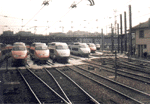
|
Outside the Villeneuve St-Georges maintenance shops on the southeast side of Paris.
From left to right, two unrenovated PSE trainsets, a 4500 series Réseau
trainset, a renovated PSE trainset, and two more unrenovated PSE trainsets. October 1997.
Photo by Yann Nottara (ynottara@mail.dotcom.fr)
|
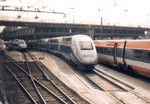
|
Outside the Villeneuve St-Georges maintenance shops on the southeast side of Paris. A
brand new TGV Duplex between two TGV PSE trainsets. October 1997.
Photo by Yann Nottara (ynottara@mail.dotcom.fr)
|
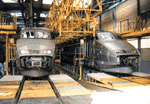
|
Inside the Villeneuve St-Georges maintenance shops, a Réseau trainset and newly
renovated PSE trainset 15. Both trainsets have their nose doors retracted, showing the
Scharfenberg automatic coupler. Overhead gantries allow access to the roof. October 1997.
Photo by Yann Nottara (ynottara@mail.dotcom.fr)
|
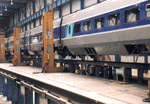
|
Inside the Villeneuve St-Georges maintenance shops, renovated PSE trainset 53 is
lifted. The lifting apparatus simultaneously lifts the entire trainset, using the TGV
trainset's standardized lift points. This allows the removal of wheelsets for maintenance
work.
Photo by Yann Nottara (ynottara@mail.dotcom.fr)
|
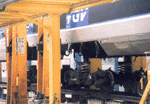
|
Another shot of trainset 53 being lifted. The bogie visible here is from the power
unit. It's difficult to see in this shot, but the traction motors stay attached to the
body.
Photo by Yann Nottara (ynottara@mail.dotcom.fr)
|
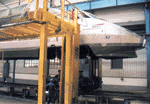
|
Another shot of PSE trainset 53 being lifted. The lift points are holes in the side of
the trainset body, into which rods are inserted for lifting (this is not visible in this
shot, but you can see the lift holes by looking at a trainset closely).
Photo by Yann Nottara (ynottara@mail.dotcom.fr)
|
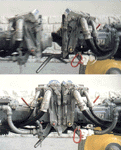 |
A demonstration of the Scharfenberg automatic coupler, which is used to couple two TGV
trainsets together. The coupler resides inside the nose shrouding of the power car, and
is exposed when the coupler doors in the nose retract. This coupler not only makes a
mechanical connection, but also connects the brake lines (compressed air) and electrical
and data cables, all without human intervention. October 1997.
Photo by Yann Nottara (ynottara@mail.dotcom.fr)
|
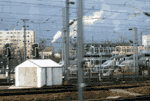
|
A small portion of the Landy TGV maintenance shops just north of Paris, snapped
from inside a passing RER train. Colored structures around three TGV Réseau
trainsets are inspection gantries. January 2000.
Photo by Clem Tillier (ctillier@alumni.princeton.edu)
|
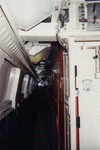
|
The gangway inside a TGV power car. There are two gangways, one to
either side of the traction equipment which sits in the cabinets in the
middle.
Photo by Anonymous
|

|
The signalling and on-board computers, located behind the cab inside
a TGV power car, at about the level of the exterior access doors. To
the right leads into the cab, and to the left is the gangway.
Photo by Anonymous
|
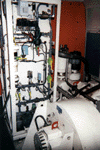
|
Miscellaneous equipment in the rear of a TGV power car. Possibly
includes brake rigging, air compressor, and traction motor blower.
Photo by Anonymous
|
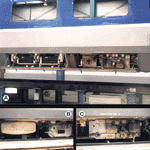
|
Some of the underfloor auxiliary equipment in TGV trailers. (A) shows the arrangement
of the equipment bays. (B) shows the part of the vacuum toilet that you would never see as
a passenger, and (C) shows brake control hardware such as electrovalves, etc. October
1997.
Photo by Yann Nottara (ynottara@mail.dotcom.fr)
|
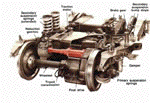
|
The Y230 bogie used on PSE, Atlantique and Réseau trainsets. The
drawing shows the traction motors, which are actually attached to the carbody and
not to the bogie frame. The tripod transmission shaft is highlighted in red.
Graphic courtesy of Prof. Bugarin of the University of La Coruna, Spain.
|

|
This is a truck (bogie) used on the TGV Duplex power cars. The gear reduction
stage on the axle is clearly visible; the tripod shaft would fit in its round
opening. A similar stage is attached to the other axle but hidden in the photo by
suspension springs. Also visible in the very foreground is the brake cylinder for
the cheek-mounted disk brake present on the wheel closest to the viewer, as well as
that furthest (the disk is actually visible in the rear).
Photo source: Railway-Technology.com
|
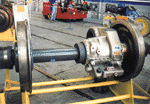
|
Part of the TGV's famous "tripod" transmission. What you see here is just the
gear reduction stage on an axle from a powered bogie. The transverse drive shaft (whose
other end would connect to the traction motor) would fit into the round opening at the
rear of the gearbox. October 1997.
Photo by Yann Nottara (ynottara@mail.dotcom.fr)
|
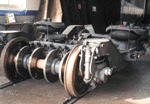
|
A TGV Duplex Y237b bogie. Each axle is equipped with four unvented brake disks. On the
end of the journal box in the foreground is a wheel tachometer, which is used by the
antilock braking system to prevent the wheel from sliding when braking. The antilock
braking control system uses a speed reference input from the train's main computer, and
compares this speed to the measured speed of the axle. The acceleration and its
derivative are used as inputs as well for the local microprocessor which controls braking
force. Villeneuve St-Georges maintenance shops, October 1997.
Photo by Yann Nottara (ynottara@mail.dotcom.fr)
|
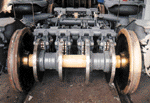
|
The same bogie as the previous shot, this time from an angle that clearly shows the
brake calipers and brake pads. The calipers are actuated by compressed air. The
large rubber bladders at the top are part of the secondary suspension. Villeneuve
St-Georges maintenance shops, October 1997.
Photo by Yann Nottara (ynottara@mail.dotcom.fr)
|
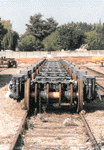
|
A row of Y237b TGV Duplex bogies sitting on a storage track. Villeneuve
St-Georges maintenance shops, October 1997.
Photo by Yann Nottara (ynottara@mail.dotcom.fr)
|
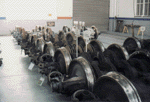
|
TGV PSE wheelsets awaiting reprofiling at the Villeneuve St-Georges maintenance shops.
These wheelsets, unlike the above Duplex wheelsets, use vented brake disks. All
trainsets since the first generation PSE trainsets have used higher performance unvented
disk brakes which have the side benefit of lowering aerodynamic drag.
Photo by Yann Nottara (ynottara@mail.dotcom.fr)
|
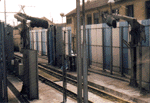
|
The trainset washing equipment at the Villeneuve St-Georges maintenance shops:
basically a big car wash.
Photo by Yann Nottara (ynottara@mail.dotcom.fr)
|
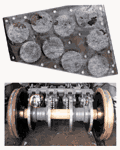
|
Part of a brake pad from the high power disk brakes found on the majority of
TGVs. The round elements are the brake pads themselves, made of sintered steel. (initially
PSE trainsets were outfitted with composite pads, since replaced
by the system shown here). As you can observe from the photo of a TGV Duplex bogie
at the bottom, there are 16 elements like the one shown here on each axle,
for a total of 144 elements per axle.
Brake pad scan provided by Jean-Emmanuel Leroy (je.leroy@ifrance.com)
Photo at bottom by Yann Nottara (ynottara@mail.dotcom.fr)
|
![]() Maintenance
Maintenance